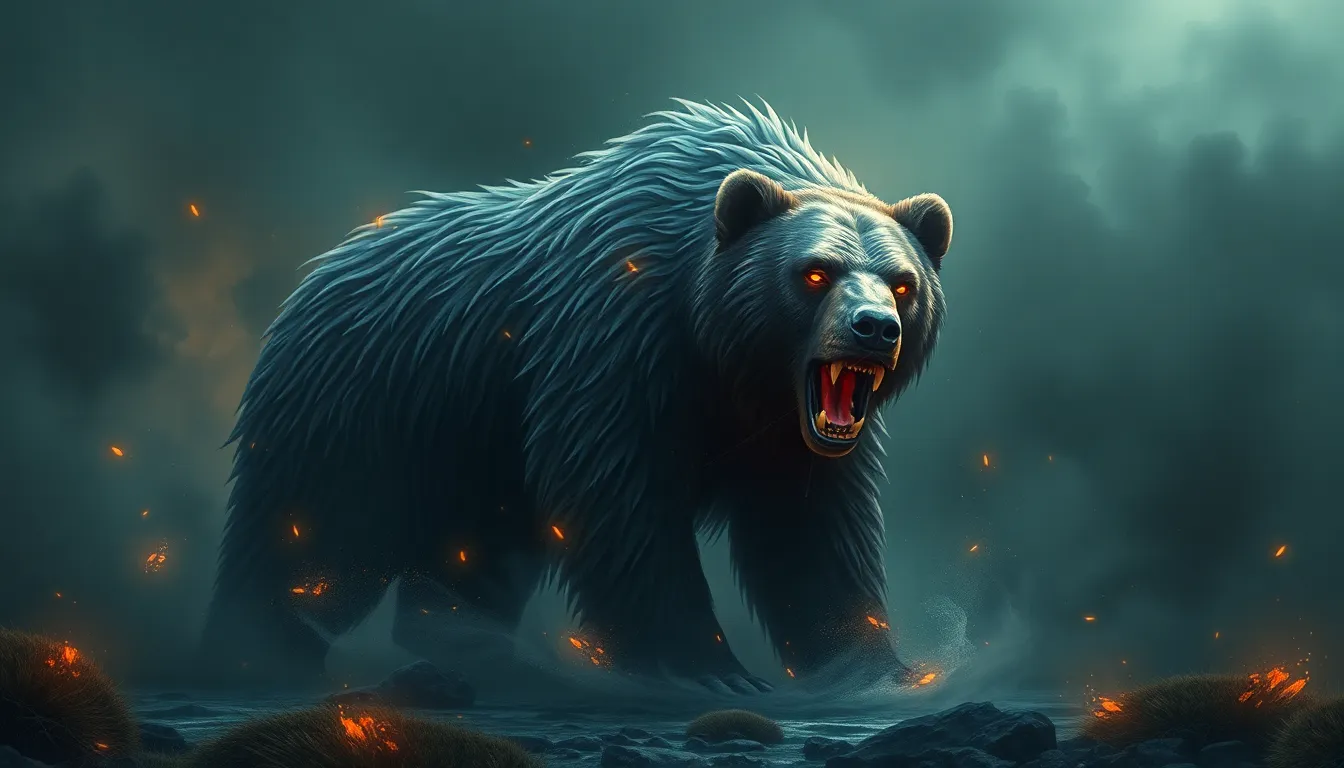The Bear in Mythology: Strength and Spirituality Combined
I. Introduction
The bear has long been a powerful symbol in various cultures around the world, representing not only physical strength but also deep spiritual significance. From ancient mythologies to modern interpretations, the bear embodies qualities that resonate with humanity’s understanding of resilience, protection, and wisdom. This article explores the multifaceted role of the bear in mythology, highlighting its importance as a symbol of strength and spirituality.
II. The Bear as a Symbol of Strength
Bears are among the largest and most powerful land mammals, and their physical attributes contribute significantly to their representation of power across various cultures.
A. Physical attributes of bears and their representation of power
The sheer size and strength of bears make them formidable creatures in nature. Their muscular build and ability to travel long distances in search of food symbolize endurance and tenacity. In mythology, these traits are often mirrored in the stories of warriors and heroes.
B. Examples of bear figures in warrior mythology
- Native American warriors: Many tribes revered the bear as a totem animal, associating its strength with the bravery of their warriors.
- Norse Berserkers: The fierce warriors known as Berserkers were said to channel the spirit of the bear, embodying its ferocity and fearlessness in battle.
C. The bear in folklore: tales of battle and resilience
Folklore often depicts bears as heroes that overcome great obstacles. Stories abound of bears protecting their young or fighting against great odds, showcasing their resilience and reinforcing their status as symbols of strength.
III. The Spiritual Significance of Bears
Beyond their physical prowess, bears hold profound spiritual significance in various traditions.
A. Bears in shamanistic traditions and their role as spirit animals
In many shamanistic cultures, the bear is viewed as a powerful spirit animal, guiding individuals through spiritual journeys and helping them connect with the spirit world.
B. The symbolism of hibernation and rebirth
The bear’s hibernation is often seen as a metaphor for introspection and renewal. Just as bears retreat into caves to rest, humans can find strength in solitude and reflection, emerging revitalized for the challenges ahead.
C. The bear as a guide in spiritual journeys and rituals
In various rituals, the bear is invoked as a protector and guide. Shamans often call upon the bear’s spirit to provide strength during healing ceremonies or vision quests.
IV. Cultural Representations of the Bear
The bear’s symbolism varies across cultures, each offering unique interpretations of this majestic creature.
A. Native American perspectives on bears in mythology
In Native American cultures, the bear is often seen as a healer and protector. Many tribes have stories that depict the bear as a wise figure that teaches important life lessons.
B. The bear in Norse mythology: a symbol of Berserkers
Norse mythology celebrates the bear as a symbol of the Berserkers, warriors who fought with the ferocity of bears. They were believed to transform into bears in battle, channeling the animal’s strength and spirit.
C. The bear in Asian cultures: sacredness and reverence
In various Asian cultures, the bear is revered as a sacred creature. For example, in some parts of China, bears are associated with strength and good fortune, appearing in folklore and art as symbols of protection.
V. The Duality of the Bear: Protector and Destroyer
The bear embodies a unique duality, serving as both a protector and a destroyer in various mythologies.
A. The bear as a guardian in various mythologies
Many cultures view the bear as a guardian spirit, protecting the land and its inhabitants. This protective aspect is seen in stories where bears defend their territory or young from threats.
B. Myths showcasing the bear’s ferocity and danger
Conversely, the bear’s strength can also be a source of danger. Myths often illustrate the bear’s fearsome side, emphasizing the respect and caution it commands from humans.
C. Balancing the protective and destructive aspects in storytelling
This duality creates a rich narrative tapestry in which the bear symbolizes the balance between strength and gentleness, danger and protection.
VI. Bears in Creation Myths
Bears also play significant roles in creation myths across various cultures.
A. Examples of bears as creators in indigenous myths
In some indigenous cultures, bears are seen as creators of the land, shaping the earth through their movements and actions.
B. The bear’s role in the creation of land, people, or nature
These myths often describe how the bear’s strength and actions contributed to the creation of rivers, hills, and even human beings, emphasizing the interconnectedness of all life.
C. Symbolic interpretations of the bear’s contribution to life
The bear’s role in creation myths illustrates its significance in the cycle of life, highlighting themes of birth, growth, and transformation.
VII. The Bear in Astrology and Zodiac
The bear also appears in astrological contexts, symbolizing various traits and influences.
A. The bear in Western astrology (e.g., Ursa Major and Ursa Minor)
In Western astrology, the constellations Ursa Major and Ursa Minor represent the bear, symbolizing strength, guidance, and protection in the night sky.
B. The significance of the bear in Chinese astrology
In Chinese astrology, the bear represents qualities such as strength, bravery, and independence, often associated with the Earth element.
C. The bear’s astrological traits: strength, protection, and intuition
Individuals born under the influence of the bear are often seen as intuitive, protective, and strong leaders, embodying the bear’s noble qualities.
VIII. Modern Interpretations of Bears in Popular Culture
In contemporary society, the bear continues to be a powerful symbol, featuring prominently in literature, film, and branding.
A. Representation of bears in literature and film
Bears are frequently depicted in stories as symbols of strength and bravery, from children’s books to epic films, often representing the struggle between good and evil.
B. The bear as a mascot and emblem of strength in modern branding
Many companies use the bear as a mascot, capitalizing on its symbolism of strength and reliability to connect with consumers.
C. Spirituality and strength of the bear in contemporary spiritual practices
Modern spiritual practices often draw on bear symbolism, emphasizing its role as a teacher and protector in personal growth and healing journeys.
IX. Bears as a Reflection of Human Experience
The bear serves as a powerful metaphor for personal growth and resilience.
A. The bear as a metaphor for personal growth and resilience
Just as bears hibernate and emerge renewed, individuals can find strength in overcoming challenges and embracing change.
B. Lessons from bear mythology applicable to modern life
Bear mythology teaches valuable lessons about courage, protection, and the importance of introspection, which can be applied to contemporary life.
C. The psychological impact of bear symbolism
The symbolism of the bear can inspire individuals to tap into their inner strength, fostering resilience and a deeper connection to their spiritual journey.
X. Conclusion
The bear, with its rich symbolism of strength and spirituality, continues to resonate in cultures around the world. As a protector, a creator, and a guide, the bear embodies the complex duality of nature and the human experience. Through its representation in mythology, astrology, and modern culture



